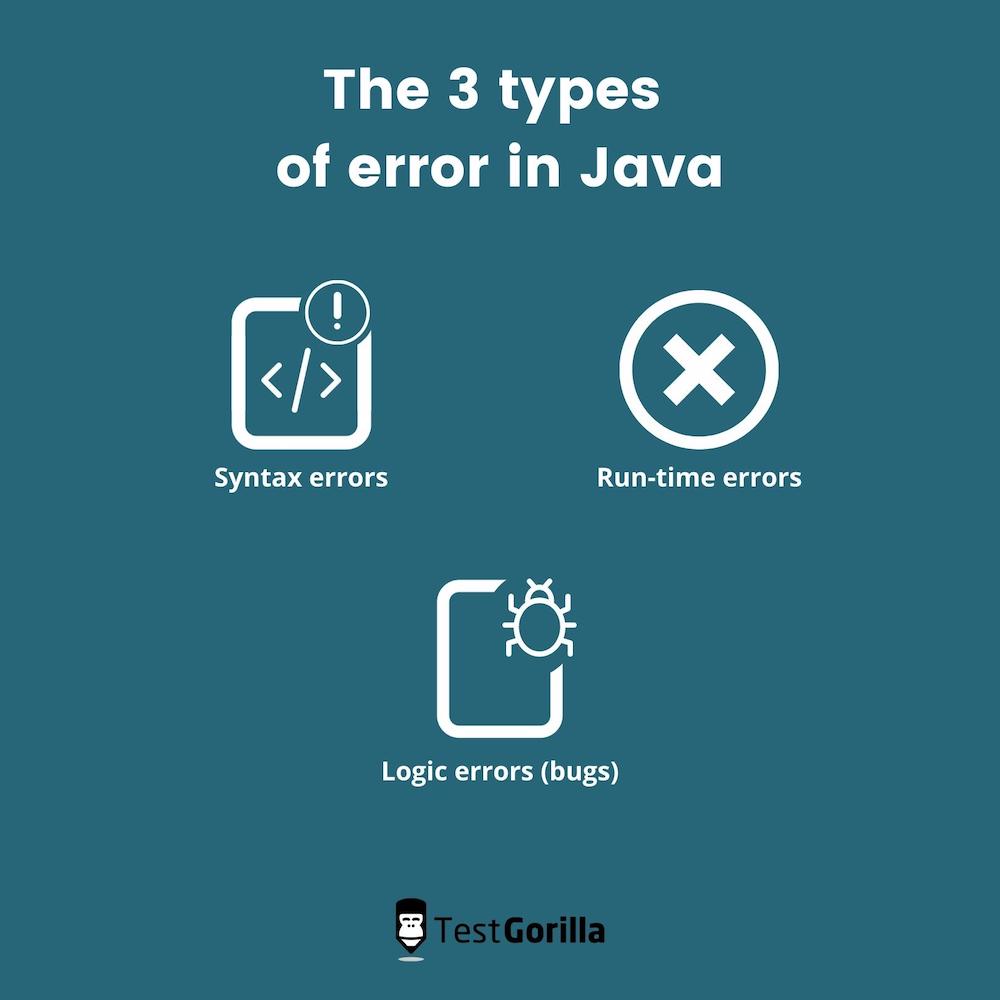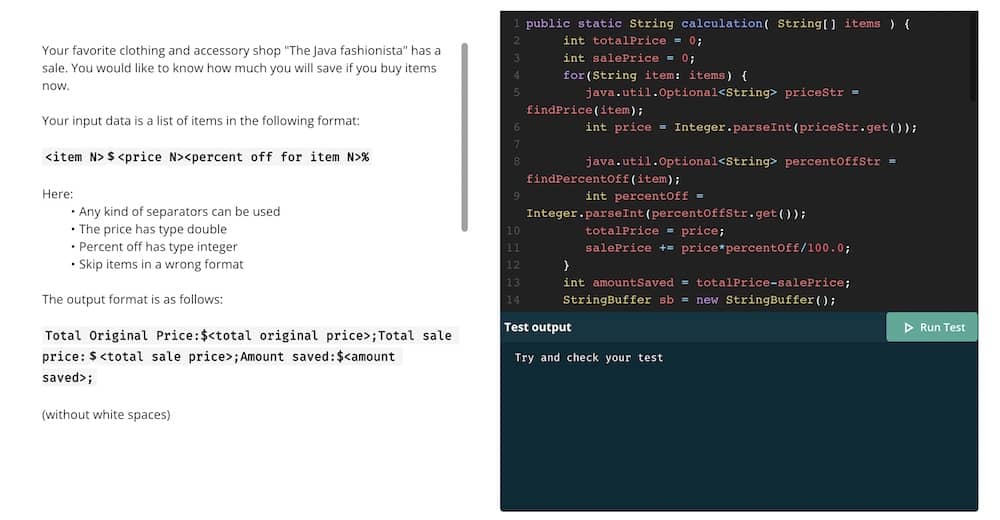Table of contents
Java is a popular programming language that is used as the server-side language for back-end development. It is the most commonly used for big data and Android app development projects, and it’s an important tool for desktop and mobile computing and embedded and enterprise-grade systems.
Because of Java’s popularity and importance, it’s vital for software developers and engineers to have Java skills. They must be able to write, understand and debug Java code.
Want to learn more about debugging Java code? Maybe you’re looking to hire a new software developer or engineer? Read on to find out more about Java debugging, top Java debugging skills, and how to test for them in your applicants.
What is Java debugging?
First and foremost, what’s a bug?
A bug is a kind of error that occurs during coding and programming. It’s also known as a logic error. There are three basic types of programming errors that can occur when programs are under development using Java.
The three types of errors in Java
Syntax errors occur when code doesn’t follow the syntax rules of a programming language. These rules govern how statements should be written, so if your program has syntax errors, you won’t even be able to execute it.
If your code has no syntax errors, run-time errors might be detected by Java during the running of a program. Java will give you an error message and a stack trace to help you trace back to the problem and fix it.
Logic errors, also known as bugs, do not cause programs to crash but produce unexpected results. In other words, your program runs, but it doesn’t do what you want it to do. The Java system provides no info to help you find the bug because it doesn’t know what your code is supposed to do, so you’ll need to get debugging.
To track down the bug and find out where the logic error must have occurred, developers need to think about what their program must have done to produce the unwanted results. They can use print statements and debuggers to help them figure out what their program is doing.
Developers spend about half of their programming time debugging. We found that debugging episodes are surprisingly frequent, where developers debug after every eight minutes of programming work.
A. Alaboudi and T. D. LaToza, ‘An Exploratory Study of Debugginig Episodes’ (May 2021)
Debugging takes up a lot of time for the people doing the coding and programming. There are no absolute rules about how you should or shouldn’t debug, but generally, the process follows these five steps.
Debugging in five steps
Notice that your program isn’t producing the results you want it to and recognize that a bug exists
Isolate the location of the bug by thinking about why your program is producing these results
Analyze the isolated section of code to identify the cause of the bug
Determine a way, or multiple ways, you might be able to fix the bug
Apply the fixes and test them to see if they work
The best insights on HR and recruitment, delivered to your inbox.
Biweekly updates. No spam. Unsubscribe any time.
Java debugging practice Q&A
Is debugging hard?
Yes, debugging is hard, and it can be extremely frustrating, too. Step 2 is often the most difficult because the source of the error isn’t always the same as the source of the symptoms.
Skilled debuggers with lots of experience will be able to come up with educated hypotheses about where the logic error might be (perhaps they have encountered and fixed a similar problem before). Less knowledgeable debuggers will often have to go through the program sequentially to discover where it is behaving differently than intended.
Steps 4 and 5 can also prove the hardest steps. These steps require in-depth knowledge of the existing system, and the more changes you make, the more opportunities you create for new bugs to appear.
How can I improve my Java debugging skills?
Learning how to debug better actually has little to do with adding, deleting, or logging code. It’s about analyzing and thinking. It’s scientific: it involves coming up with hypotheses about what and where the bug might be and testing these hypotheses until you find the bug’s location, grasp what’s happening, and fix it. Because of this, the best way to get better at debugging is to practice.
Where can I practice debugging Java code?
Here are five popular websites where programmers can practice Java coding:
HackerRank
TopCoder
Project Euler
Coderbyte
Codewars
How can I avoid bugs in Java?
Unfortunately, bugs can’t be avoided altogether, but some errors are more avoidable than others. Some steps you can take to prevent easily avoidable bugs whilst programming are:
Type accurately. Many bugs are caused by simple typos.
Listen to your Integrated Development Environment (but not too much). Most IDEs will offer hints if something is up with your code. Overly confident IDEs can autofill code, so keep an eye out for this, too.
Break up your code. As your code grows, so does the possibility of bugs, so keep methods short and give each class only one responsibility where you can.
Reuse existing code. Leveraging tried and tested code might just be the easiest path to bug avoidance, and it saves time, too.
How do debugging tools help developers?
Debugging tools, also known as debuggers, are used to identify coding errors. An IDE will often have a debugging component or tool that reports errors immediately and enables programmers to see the code’s memory and variables, run programs to specific breakpoints, or execute a specific amount of code. With the right debugging tools, software engineers can simplify and speed up the debugging process.
What are the best Java debugging tools?
All popular IDEs come with all the tools needed for a smooth and straightforward debugging process. Because of this, IDEs are most commonly used for debugging java applications.
Java Discovery Protocol (JDP) is a command-line debugging tool supported by Oracle, the company that owns Java. Since it’s internal you can use it without the difficulty of connecting to an external tool. But, because it doesn’t include a simple graphical interface for users, it can be a complex tool to use. JDeveloper, a freeware IDE by Oracle, has debugging tools that are easier to use.
Eclipse is a well-known open-source IDE that has Java debugging tools built into it. It is considered one of the strongest and most reliable IDEs for Java development today. As well as standard debugging functions, it has some notable features. Debug Perspective, for example, shows users their code and the relevant debugging info side-by-side for convenience.
NetBeans is one of the best open-source Java IDEs, and this is largely due to the wide range of debugging functions that it comes with. It is easy to install and use, and has a useful Visual Debugger for debugging an application’s visual features.
Debugging tools aren’t always tied to IDEs. Visual Studio Code, for example, can be used by simply downloading a Debugger for Java extension. It doesn’t have some of the more advanced features that IDEs can offer, but it has basic debugging functions and might be adequate for your application.
7 tips for Java debugging
Here are some tips for improving your Java debugging practice.
Realize that you don’t understand what is going on, and don’t stop until you do, even if you manage to get the program working as it should.
When you are first writing the code, carry out frequent integrity checks so the program can detect and report any problems.
Perform syntax checks on all input data that comes from users – invalid user data is a common error source, and any new user might uncover a new group of bugs.
Use log files. Information about what was happening before, during, and after a problem occurred can be useful for the debugging process.
Use test suites and automate them to reduce the effort required to perform tests when debugging.
Apply changes one at a time. Test them thoroughly before moving on to the next change, and take out any changes that don’t actually change the program’s behavior.
When you encounter a bug, think about where the same mistake might also be likely – once you know how to solve something, you may as well check if you can fix the same problem elsewhere.
Java debugging skills
If you need to hire an engineer or developer for your team, you should ensure that they have excellent debugging skills. To identify these skills in candidates efficiently and reliably, you should implement universal coding tests into your recruitment process. This way, you can place your applicants on an even playing field and reduce hiring bias.
For an extensive list of skills tests that you can give to your software engineer and developer candidates, you can simply search for ‘Java Developer’ in our test library. But generally, candidates who are proficient at debugging in Java will be proficient in:
Writing and understanding code
These are the fundamentals. Your candidates should be able to write and understand code using whatever programming languages and frameworks your engineering team uses on the front and back ends of development.
Our JavaScript (coding): entry-level algorithms and PHP (coding): intermediate-level algorithms tests are two examples of tests that will assess coding abilities in candidates. We offer a range of entry-level and intermediate tests for evaluating querying and database operations, and assessments for a range of frameworks, too. Check them out in our test library.
For teams specifically focused on mobile development, our Android Development Using Java test evaluates candidates' abilities in networking and database management, UI/UX interface design, and testing with DevOps integration – essential skills for developing robust Android applications
Attending to details to write accurate code and spot bugs
As we discussed earlier on in the blog post, writing code accurately and exercising attention to detail are vital skills for developers, programmers, and engineers to have. It can help them escape the most avoidable of bugs, which come from typos. It also comes in handy for debugging: with strong attention to detail, you’re more likely to spot where a line of code doesn’t look as it should.
Our attention to detail (textual) test might come in handy here since it assesses candidates’ ability to pay close attention to textual detail while processing information. This is a key analytical skill for any software development role.
In addition, you can use our clean code test to assess candidates’ code readability and simplicity. This ten-minute test will help you hire programmers who are able to write ‘clean code,’ as defined by prolific computer scientist Robert C. Martin. High-quality code is code that doesn’t need refactoring, it saves time and money and is less prone to bugs.
Using analytical and critical thinking abilities to fix bugs
If you want to hire candidates who are excellent debuggers, we strongly recommend giving them at least one cognitive ability test alongside debugging and software-specific tests.
Our critical thinking test is a great option. It’s an advanced assessment that will evaluate applicants’ aptitude in thinking critically and independently to solve complex problems. It covers:
Solving syllogisms (deductive reasoning)
Interpreting sequences and arrangements
Understanding cause and effect relationships
Recognizing assumptions
Our numerical reasoning test is also recommended for any roles where numerical aptitude is important. It covers:
Interpreting numbers, fractions, and percentages
Understanding number patterns
Interpreting text and tables
Interpreting charts, graphs, and diagrams
All of our assessments are heavily researched and tested and are built by subject matter experts from relevant fields and industries.
Testing Java debugging skills: The Java (coding): debugging test
These are all helpful options, but if you want to hire an excellent Java debugger, there’s one test you must give to candidates. Our Java (coding): debugging test is the best way to assess Java code interpretation and debugging skills.
How does it work?
Candidates who open the debugging test will see a set of requirements and a partially working script like the one depicted below:
They will have 30 minutes to use the description to clarify the code’s objective and understand how it should function. From here, they should be able to identify the bugs and fix them. They will be able to run the code throughout to see if inputs generate the desired result.
Once their code has been submitted, your candidates will be scored using a broad set of test cases. These include more challenging corner cases too. You’ll be able to go in and inspect the code each applicant produces. We’ve incorporated a playback function so that you can observe the test-taker’s processes and see how they came to their solutions.
Don’t use this test alone to evaluate candidates
In order to paint a well-rounded picture of your candidates and decide which of them you want to shortlist and interview, you’ll need to give them a range of tests. We suggest a maximum of five tests and recommend that you include custom questions in your assessment. With TestGorilla, it’s easy to build an assessment that incorporates multiple elements.
Some of our most popular tests assess the personality and culture of candidates. These tests open up a dimension often overlooked in the recruitment process – and if it’s not overlooked, it’s used to consciously or unconsciously make biased decisions about applicants. We recommend:
A culture add test will assess how well aligned a candidates’ values and behaviors are with your organization. You’ll customize the test to your company’s values and the behaviors which are important to the role.
An innovative addition to the test library, our motivation test measures to what extent your candidates’ expectations align with the job you are offering. It’s based on a customized survey you and the candidate both fill out.
Use TestGorilla to hire the best without bias or stress
TestGorilla will equip you with everything you need to build assessments and effectively evaluate candidates for debugging skills and anything else that’s relevant. We’ve also got you covered if you want to continue assessing debugging skills in the interview stage.
Skills-based hiring is the future, so what better way to hire a new developer than using a skills assessment? Check out our pricing plan and pick something that works for you, or get started with a free plan today.
You've scrolled this far
Why not try TestGorilla for free, and see what happens when you put skills first.
























